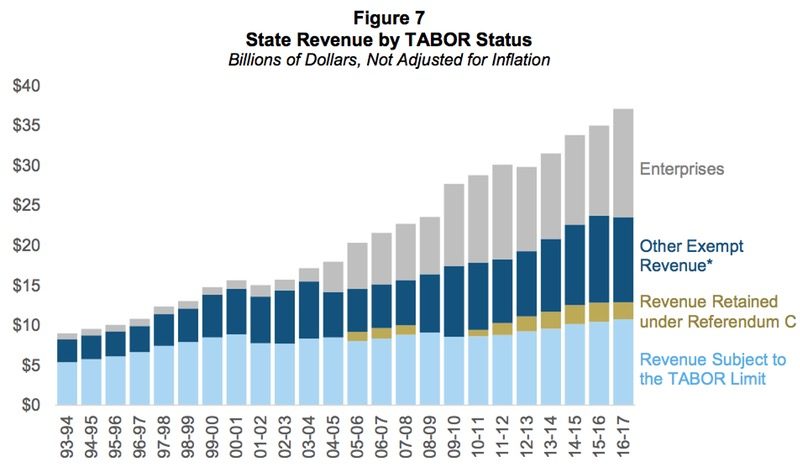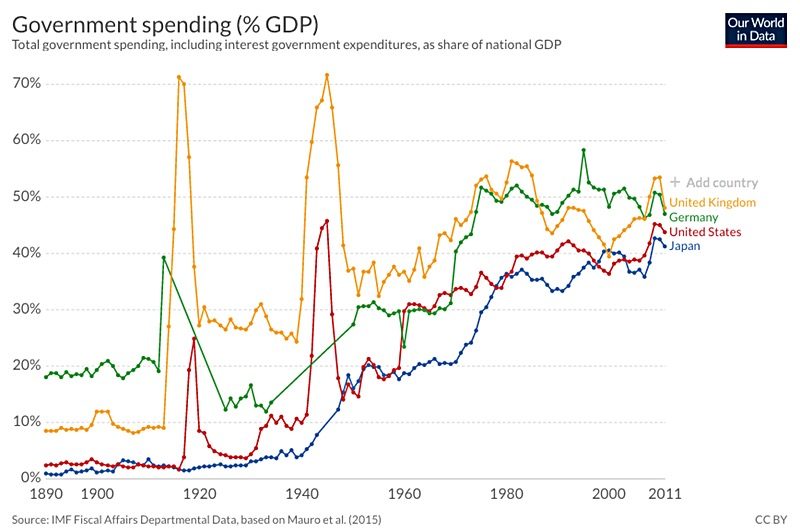During the rollout for the “YES on Proposition CC” campaign earlier this month, Colorado Governor Jared Polis referred to a section of the Colorado Constitution — the Taxpayers Bill of Rights, better known as TABOR — as an “arbitrary, antiquated formula,” and other supporters at the campaign kickoff emphasized that the Proposition CC is just a ‘start’ to a broader conversation about needed changes to the state’s fiscal system.
“I think this is a good first step in educating the voting taxpayers and public about what TABOR does and how it does affect essential services for the state of Colorado,” said Treasurer Dave Young, a Democrat, in an interview after the “YES” committee kickoff event.
The problem with the state’s fiscal system being, “not enough money to spend.” Or possibly, a government that has grown so fat, it can’t find enough money to keep itself satisfied? There is no doubt that the TABOR amendment, approved by the Colorado voters in 1992, has hindered the growth of the state government to some degree, although the Legislative Legislative Staff chart we shared in the previous installments of this editorial series suggest that the state government has found numerous ways to grow, in spite of TABOR.
Here is that chart once again, showing the somewhat fabulous growth of our state government since 1993, the year after TABOR was approved.

This chart suggests that TABOR may have had a mitigating effect on “Big Government” for about 12 years, until the state’s lawyers and politicians dreamed up Referendum C, back in 2005. The clever folks in Denver also became adept at establishing new “fees” to fuel government expansion, whenever they felt shy about asking the voters to approve a tax increase — or whenever the citizens voted “NO” on their government growth proposals.
This pattern of government expansion is not unique to Colorado, of course. Yes, we’re the only state with a “Taxpayers Bill of Rights” — but even that constitutional amendment has seemingly become ineffective at slowing government growth.
Nor has the rather spectacular growth of government been limited to the US.
Here’s another chart. (I love charts.) It compares government spending in four “early-industrialized” countries — US, UK, Germany and Japan — with the GDP (Gross Domestic Product) in each country.

We might be able to perceive four fairly distinct periods in this chart. In the first period, up until the First World War, government spending was generally low, especially in Japan and the US. Total government spending in the US (I assume, for all levels of government?) accounted for less than 5% of national income. These low levels of public spending were just enough for governments to be concerned with basic functions, such as maintaining order and enforcing property rights.
Between World War I and the end of World War II — including the Great Depression — government spending became more volatile. Then from about 1950 until about 1980, spending in all four of these industrialized countries climbed quickly, compared to GDP. Since 1980, the growth has been rather flat — but it’s still well above 40% here in the US. Quite a difference from 1915.
How about the State of Colorado? In 1990, the state’s GDP was about $76 billion, and total state spending was $4.7 billion — or about 6% of the state’s GDP.
2000: Colorado’s GDP was about $181 billion. State expenditures were $10.2 billion — a little less than 6% of GDP.
2020: Colorado’s total economy will be about $407 billion. State spending will be about $32 billion. That’s about 8% of the state’s GDP.
Is this a government that desperately needs more money? Like, for example, is this a government that needs to have the voters repeal Article X, Section 20 of the Colorado Constitution?
The folks promoting Proposition CC have made it pretty clear that CC is seen as a “rehearsal” for the full repeal of Article X, Section 20 of the Constitution. TABOR.
Last year, pro-tax activist Carol Hedges and her Colorado Fiscal Institute developed a whopping 18 different proposals for the 2020 ballot regarding changes to the state’s tax laws, all designed to test how many constitutional changes they could legally fit into a single ballot initiative without violating Colorado’s “single subject” rule. That rule legally requires legislation and ballot measures alike to clearly address one single topic — such as transportation, or criminal justice — and one topic only.
Article X, Section 20 is complex. It doesn’t merely require taxpayer refunds when state revenues grow too fast. Parts of TABOR also apply to county and town governments — requiring voter approval for tax hikes and government debt, for example. It prohibits real estate transfer taxes, and forbids tiered tax brackets based on income. It directs when and how to conduct different kinds of elections.
The Colorado Fiscal Institute filed their Version #3 with the Colorado Secretary of State’s office last January, aimed at repealing TABOR entirely. Two weeks later, the state title board decided the measure did not constitute a single subject. But on June 17, the Colorado Supreme Court reversed the title board’s ruling, declaring that the initiative did in fact constitute a single subject, and directed the title board to set a ballot title.

The ballot title set by the title board is as follows:
“An amendment to the Colorado constitution concerning the repeal of the Taxpayer’s Bill of Rights (TABOR), Article X, Section 20 of the Colorado constitution.”
Proponents then filed a motion for a rehearing on the title, seeking to have the words “Taxpayer’s Bill of Rights” and “TABOR” removed from the ballot language. Initiative sponsor Carol Hedges argued that references to the Taxpayer’s Bill of Rights “would confuse voters.”
“We need to keep a simple title that allows voters to know what they are voting on,” she argued. “And it’s very clear from a title that says repeal Article X, Section 20, what is happening. Any voter that doesn’t know what Article X, Section 20 is, will go to the Colorado Constitution and learn what it’s about.”
The rehearing was denied. The TABOR repeal advocates have until August 3, 2020 to submit 124,632 valid petition signatures in order to place their measure on the ballot.
As noted, Proposition CC is merely a rehearsal for 2020, when we might have a chance to totally remove the taxpayer protections written into the Colorado Constitution — all of the protections.
